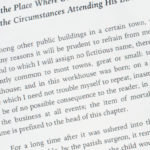
Teaching Logic and Sequencing through Narrative
As a writing teacher, I’ve discovered that counseling writers to sequence details logically does more for their writing, their readers, and their intellectual development than

As a writing teacher, I’ve discovered that counseling writers to sequence details logically does more for their writing, their readers, and their intellectual development than

Let’s never read student writing again. In fact, let’s not even talk about it.
Not because student writing is dull or unworthy of serious